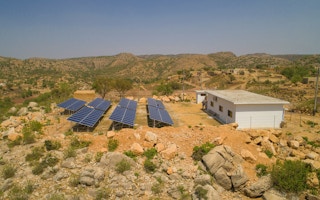Pakistan’s government has proposed to eliminate taxes associated with manufacturing of solar and wind energy equipment in the country, in an effort to boost the production and use of renewable power and overcome power shortages.
A new government budget bill, expected to be approved in parliament within a month, would give renewable energy manufacturers and assemblers in the country a five-year exemption from the taxes.
“Pakistan is paying the heavy cost of an ongoing energy crisis prevailing for the last many years,” Finance Minister Asad Umar said last week in a budget speech.
“In this difficult time, the promotion of renewable energy resources like wind and solar has become indispensable.”
Only about 5 to 6 per cent of the power to Pakistan’s national electrical grid currently comes from renewable energy, according to the country’s Alternate Energy Development Board (AEDB).
“
In this difficult time, the promotion of renewable energy resources like wind and solar has become indispensable.
Asad Umar, Finance Minister, Pakistan
The proposed tax reduction should boost that by encouraging greater local manufacturing of equipment needed for renewable power expansion, said Asad Mahmood, a renewable energy expert with the National Energy Efficiency and Conservation Authority, which sits within the Ministry of Energy.
Remaining hurdles
But manufacturers said the tax breaks likely would not be sufficient to spur expansion of local renewable energy industries.
Naeem Siddiqui, the chairman of Ebox Systems, which assembles solar panels in Islamabad, said the new tax breaks were good news but Pakistani manufacturers would still struggle to compete with tax-free, low-priced imports of foreign-built solar panels and other renewable energy equipment.
“The government has already waived off taxes and duties on the import of renewable energy products, and local manufacturers cannot compete with the low-priced imported items,” he said.
Pakistan today imports more than 95 per cent of the solar panels and other renewable energy systems it uses, largely from China, said Aamir Hussain, chief executive officer of Tesla PV, one of the largest manufacturers of solar energy products in Pakistan.
“As long as the government will not impose duties on the import of finished products, the local market cannot grow,” he said.
Pakistani manufacturers also might need government help in pushing sales of new Pakistani clean energy products abroad, in order to build bigger markets and lower manufacturing costs, Siddiqui said.
Mahmood, of the energy ministry, said he believed the government would also move to cut existing duties on the import of components used in manufacturing finished renewable energy products, in order to help Pakistani manufacturers.
Taxes on those components have pushed up prices of Pakistani-made renewable energy systems, making them harder to sell and leading several companies to the brink of failure, he said.
Local manufacturers should work with the government to determine which components should be manufactured locally and which imported to ensure costs of locally made wind and solar systems are competitive, he said.
Muhammad Abdur Rahman, managing director of Innosol, a company that imports and installs renewable energy systems, said that cheap imports of renewable energy systems from China remain the main barrier to building more such systems in Pakistan.
“The local industry is facing pricing issues because of low-quality solar energy appliances being imported in the country that are very cheap as compared to the local market,” he said.
That might be resolved in part by the government starting a certification system for renewable energy products to grade them according to quality, he said.
Amjad Ali Awan, chief executive officer of the Alternate Energy Development Board, said the aim of the new policies was for renewable energy to supply 28 to 30 per cent of the country’s national electrical grid by 2030.
This story was published with permission from Thomson Reuters Foundation, the charitable arm of Thomson Reuters, that covers humanitarian news, climate change, resilience, women’s rights, trafficking and property rights. Visit http://news.trust.org/climate.

















